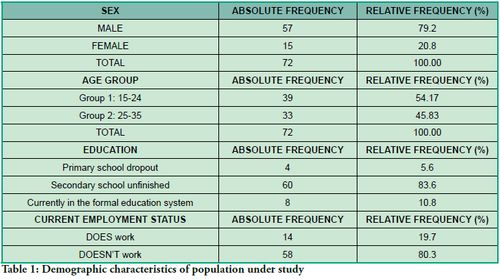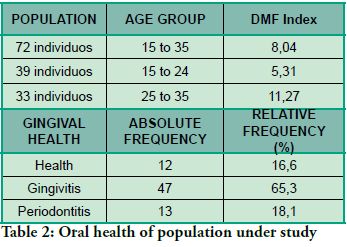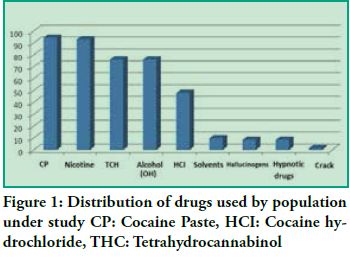Servicios Personalizados
Revista
Articulo
Links relacionados
Compartir
Odontoestomatología
versión impresa ISSN 0797-0374versión On-line ISSN 1688-9339
Odontoestomatología vol.17 no.25 Montevideo mayo 2015
Dental and periodontal condition of a population in treatment for drug use. Pilot study
Rotemberg Enrique*, Salveraglio Inés**, Kreiner Marcelo***, Piovesan Sylvia****, Smaisik Karinna*****, Ormaechea Rocio******, Varela Alicia*******
* Associate Professor, Department of General and Oral Physiology, School of Dentistry, Universidad de la República. Uruguay. erotemb@yahoo.com.ar
** Associate Professor, Department of Pediatric Dentistry and Professor, Patient Admission and Registry Department, School of Dentistry, Universidad de la República. Uruguay
*** Professor, Department of General and Oral Physiology, School of Dentistry, Universidad de la República. Uruguay
**** Assistant, Patient Admission and Registry Department, School of Dentistry, Universidad de la República. Uruguay
***** Doctor of Dentistry, School of Dentistry, Universidad de la República. Uruguay
****** Doctor of Medicine, School of Medicine, Universidad de la República. Uruguay
******* Lic. Assistant, Department of Quantitative Methods, School of Medicine, Universidad de la República. Uruguay
Abstract
Problematic drug use may affect the oral health of consumers. This research was designed to detect the prevalence of dental and periodontal pathology in an adolescent and young adult population in treatment for drug dependence.
A transversal, observational, descriptive study was conducted. It included 72 subjects being treated for drug addiction at Portal Amarillo, a national reference center.
The mean value of the DMF Index was 8.04. When discriminating by age group, in the ages between 15 and 24 the DMF Index was 5.31, while in the ages between 25 and 35 it was 11.27. The periodontal survey showed that 65% of the participants suffered from gingivitis and 18% from periodontitis.
The results showed a greater prevalence of oral disease in patients who are drug addicts than in the rest of the population. First level health services should take special prevention and early detection measures when treating patients who are drug addicts.
Keywords: oral health, drugs, addiction.
Received on: 04.12.2014 - Accepted on: 25.02.2015
Introduction
Various factors can impact the oral health of patients. For example, some studies have shown that illegal drug use has a negative effect on hygiene habits and on the prevalence of decay and periodontal disease (1, 2). Injection drug users in particular, of drugs such as heroin, appear as a high-risk group in a recent study conducted in Bosnia and Herzegovina (3). Additionally, a study conducted among heroin consumers in China showed a higher prevalence of decay, gingivitis and periodontitis than the general population (4). The withdrawal period during drug addiction treatment is critical for oral health, mainly due to poor oral health behavior (OHB) (5). Substance abuse by pregnant women can increase the incidence of decay and periodontal disease during gestation as oral hygiene is neglected, among other things (6).
Drug use is a social phenomenon that has existed since the beginning of humankind. Both the people who decide not to use drugs and those who face problematic drug use need information (7). Drugs have been used throughout history in religious ceremonies, to improve resistance, to alleviate hunger and fatigue, for medical purposes, as anesthetics, for social or recreational uses, etc. (8). Psychotropic or psychoactive drugs are substances whose main effect is on the central nervous system (CNS). They change the user’s mood, behavior, consciousness and perceptions. They are classified into depressants, stimulants and hallucinogens according to their effect on the CNS. Following the method of use, drugs can enter the body through intranasal inhalation (cocaine, glue) smoking (tobacco, marijuana, cocaine paste); or orally or by ingestion (alcohol and synthetic drugs); intravenous injection (heroin), and other less frequent methods like via the rectum and submucosa (9). In February 2007, the National Program for Problematic Drug Users stated that: ‘Substance use should be detected early in all users of health services, particularly in the case of children, adolescents and pregnant women’ (10). Portal Amarillo has been the National Focal Point of the Drugs Network since 2006. It combines three care methods for State Health Services (ASSE) users: outpatient, day and inpatient treatments (11).
There is scarce epidemiological information regarding the possible connection between illegal drug use and dental and periodontal health in Uruguay. The aims of this study were to detect the prevalence of these pathologies in an adolescent and young adult population in treatment for drug dependence, and to achieve oral rehabilitation seeking to improve the patients’ health and social reintegration process.
Materials and methods
This was a transversal, observational, descriptive study conducted on a population of males and females aged between 15 and 35. Consecutive individuals attending Portal Amarillo in Montevideo, Uruguay, in treatment for problematic drug use in the 2012-2013 period were evaluated. The sample included 72 subjects: 57 males and 15 females (average age of 24). The study was conducted by examiners calibrated with Kappa coefficient 0.9 in diagnosis of decay and periodontal disease. Questionnaires and examinations were held with the patient sitting on a regular chair in a well-lit environment. Examiners used a disposable dental mirror and a sterile metallic periodontal probe with round tip approved by the WHO. The DMF index was used to indicate decayed (D), missing (M) and filled (F) teeth.
The complete prosthetic rehabilitation of patients was coordinated with ASSE institutions (Centro Hospitalario Regional Norte Gustavo Saint Bois, Centro Giordano and Hospital Maciel).
Ethical issues
The protocol was evaluated by the Ethics Committee of the School of Dentistry, Universidad de la República. Authorization from the Board of the Portal Amarillo was obtained. The participants, who volunteered for the study, or their legal representatives signed the corresponding informed consent.
Results
Table 1 shows socio-demographic information and table 2 the oral health of participants. Figure 1 shows information about the drugs used by patients.
The periodontal survey based on the Community Periodontal Index (CPI) shows that of the 72 individuals examined, 12 (16.6%) have good gum health, 47 (65.3%) suffer from gingivitis, and 13 (18.1%) have periodontitis. The 25-35 age group has a smaller number of individuals with good gum health (4 to 8) compared to the 15-24 group, as well as a greater number of individuals with periodontitis (12 to 1).
Regarding the total sample, 18 needed prosthetics: 25% of the population.
Discussion
This work provides new information about the oral health of patients in treatment for drug dependence in Uruguay. Studies with similar objectives conducted in other countries reported a higher prevalence of various indicators of dental disease compared to the general population (1, 2, 12-14). The results of this study show a higher prevalence of disease than in the general population compared to the results of the 2010-2011 First National Survey on Oral Health conducted among Uruguayan young people and adults (15).
These data show that the use of psychoactive substances among adolescents and young adults may have a major impact on the health of the stomatognathic system. For example, studies conducted in Córdoba, Argentina, with 61 drug-addicted adolescents and young people in recovery reported gingival and periodontal alterations in 81.7% of the cases (12). Another study on an adolescent population attending the Hospital of Mental Health San Francisco de Asís, Corrientes, Argentina, in rehabilitation for the use of multiple drugs, found that 65% of the sample (n=30) suffered from gingivitis (13). Through the comprehensive approach of the male individuals in a Recovery Institution (n=102) in Bauru, Sao Paulo, 29.17 years of age on average, a DMF index of 14.88 was recorded (16). This trend is also observed in countries considered more developed. A study conducted in San Francisco (US) reported a significant increase in the prevalence of dental disease (decay, radicle remains, etc.) in a population of young drug-addicts (n=58) compared to the general population of the United States (2).
Apparently, not all illegal drugs have the same potential to harm patients’ general and orofacial health. In an interesting study conducted in the 1970s, the “paired samples” test was used to compare heroine and opium users. It was observed that heroin addicts used more substance per day, required higher doses of methadone during detox and sought treatment earlier that opium addicts. In brief, the study concluded that heroin is more “pathogenic” than opium (17). Additionally, regarding oral health, a more recent comparative study did not find differences between heroin addicts and methamphetamine addicts (2).
This study showed that 25% of the participants needed dental rehabilitation by means of prosthetics. Satisfying this demand is crucial for the social integration of drug addicts. As the aim of this study was to make contributions in this regard, the complete prosthetic rehabilitation of some patients in the sample was coordinated with ASSE institutions (Centro Hospitalario Regional Norte Gustavo Saint Bois, Centro Giordano and Hospital Maciel). Funding was obtained from the 2012 Competitive Funds offered by the National Drug Secretariat.
Conclusions
The DMF Index value for the 15-24 age group is higher than that of the general population as reported in the 2010-2011 First National Survey on Oral Health conducted among Uruguayan young people and adults from outside the capital (18). The data obtained from the periodontal examination show values that are similar to those of regional studies, as well as a higher prevalence of gingival and periodontal alterations compared to the general population of Uruguay (19).
The study of two age groups from individuals attending Portal Amarillo showed that years of drug use increase the prevalence of the most frequent oral pathologies: decay and periodontal disease.
Addictive behavior linked to drug use affects the development and health of adolescents. First level health services should take special actions regarding promotion, prevention, early detection, care, referral, follow-ups and support.
Acnowledgements
study funded by the National Drug Board, the School of Dentistry, UdelaR and the Sectoral Commission of Scientific Research, UdelaR, Uruguay. We would like to thank the Dentistry Department of ASSE in the framework of the National Drug Secretariat - School of Dentistry, UdelaR Agreement.
1. Gupta T, Shah N, Mathur VP, Dhawan A. Oral health status of a group of illicit drug users in Delhi, India. Community Dent Health. 2012; 29:49-54.
2. Brown C, Krishnan S, Hursh K, Yu M, Johnson P, Page K, Shiboski CH. Dental disease prevalence among methamphetamine and heroin users in an urban setting: a pilot study. J Am Dent Assoc 2012; 143:992-1001.
3. Supic ZT, Petrovic R, Milicevic MS, Trajkovic G, Bukumiric Z. The oral health of heroin drug users: case study in Bosnia and Herzegovina. BMC Public Health 2013 Dec 19;13:1202. doi: 10.1186/1471-2458-13-1202.3. Supic ZT, Petrovic R, Milicevic MS, Trajkovic G, Bukumiric Z. The oral health of heroin drug users: case study in Bosnia and Herzegovina. BMC Public Health [en línea] 2013 Dec 19;13:1202. Fecha de acceso: 10 febrero 2015. doi: 10.1186/1471-2458-13-1202. Disponible en: http://www.biomedcentral.com/1471-2458/13/1202
4. Ma He, Shi Xin-chang, Hu De-yu, Li Xue, The poor oral health status of former heroin users treated with methadone in a Chinese city. Med Sci Monit. 2012; 18(4): 51-55.
5. Shekarchizadeh H, Khami MR, Mohebbi SZ, Virtanen JI. Oral health behavior of drug addicts in withdrawal treatment. BMC Oral Health. [en línea] 2013 Jan 31; 13:11. Fecha de acceso: 10 febrero 2015. doi: 10.1186/1472-6831-13-11. Disponible en: http://www.biomedcentral.com/1472-6831/13/11
6. Saini GK, Gupta ND, Prabhat KC. Drug addiction and periodontal diseases. J Indian Soc Periodontol 2013; 17:587-91.
7. Valentini Sanguinetti G. Diabetes y Drogas: más información, más prevención, menos riesgos. Diabetes al día. 2012 8; (88): 4-5.
8. Rees TD. Oral effects of drug abuse. Crit Rev Oral Biol Med 1992; 3(3): 163-184
9. Uruguay. Presidencia de la República. Junta Nacional de Drogas. Drogas: más información menos riesgos. 8ed. Montevideo: Junta Nacional de Drogas, 2009.
10. Uruguay. Ministerio de Salud Pública. Dirección General de la Salud. Programa Nacional de Salud Adolescente. Guía para el Abordaje Integral de la Salud de Adolescentes en el Primer Nivel de Atención. Tomo I. Montevideo: Ministerio de Salud Pública, 2009.
11. Triaca J, Cardeillac V, Idiarte Borda C. Características de los primeros usuarios que consultaron en el Centro de Referencia Nacional de la Red Drogas “Portal Amarillo”. Rev Psiquiatr Urug 2009; 73(1): 37-48.
12. Gigena P, Bella MI, Cornejo LS. Salud bucal y hábitos de consumo de sustancias psicoactivas en adolescentes y jóvenes drogodependientes en recuperación. Odontoestomatología 2012; 14(20):49-59
13. Barrios CE, Vila VG. Salud bucal en drogodependientes. Rev Facultad de Odontología UNNE 2010; 3(3): 38-43
14. Ruiz Candina H, Herrera Batista CA, Martínez Betancourt A. Periodontopatías en jóvenes y adolescentes adictos a drogas psicoactivas, atendidos en el Centro de Deshabituación de Adolescentes, del Municipio Playa. Rev cuba invest bioméd.[en línea] 2014; 33(1). Fecha de acceso: 10 febrero 2015. Disponible en: http://bvs.sld.cu/revistas/ibi/vol33_1_14/ibi 07114.htm
15. Lorenzo S, Álvarez R, Blanco S, Peres M. Primer Relevamiento Nacional de Salud Bucal en población joven y adulta uruguaya. Aspectos metodológicos. Odontoestomatología. 2013; 15(Nº Especial): 8-25.
16. Del Peloso Ribeiro E, Alves de Oliveira J, Pelissari Zambolin A, Pereira Lauris JR, Tomita NE. Abordagem integrada da saúde bucal de drogo-dependentes em proceso de recuperaçao. Pesqui Odontol Bras 2002; 16 (3): 239-245.
17. Westermeyer J, Peng G. Opium and heroin addicts in Laos. II. A study of matched pairs. J Nerv Ment Dis. 1977 May;164(5):351-4.
19.
Lorenzo S, Piccardo V, Álvarez F, Massa F, Álvarez R.
Enfermedad periodontal en la población joven y adulta uruguaya
del interior del país: Relevamiento Nacional 2010-2011.
Odontoestomatología. 2013; 15(Nº Especial): 35-46











 texto en
texto en 





